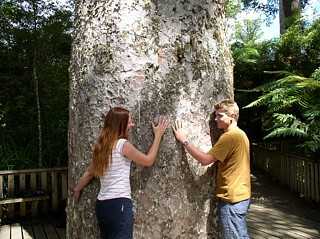Kauri
are among the world's mightiest trees, growing
to more than 50 metres tall, with trunk
girths of up to 16 metres. They covered
much of the top half of the North Island
when the first people arrived around 1000
years ago.
Maori used their timber
for boat building, carving and housing and
their gum for starting fires and chewing
(after it had been soaked in water and mixed
with the milk of the puha plant).
The arrival of European
settlers last century saw the decimation
of these magnificent forests. Sailors found
the trunks of young kauri were ideal for
ships' masts and spars and settlers who
followed discovered the mature trees yielded
sawn timber of unsurpassed quality for building.
The gum, too, became essential
in the manufacture of varnishes. Gum was
obtained through digging, fossicking in
treetops, or, more drastically, by bleeding
live trees. The exploitation of forests
increased with the demand for more and more
cleared farmland. Kauri forests once covered
1.2 million hectares; now they have been
reduced to 80,000 hectares.
A lasting reminder of
the once-thriving kauri industry are the
kauri dams which walkers can see relics
of around the Coromandel. Kauri driving
dams were built by loggers to drive large
quantities of kauri logs downstream from
remote areas. While they played a major
role in the destruction of the forest, they
were also impressive.
There are still stands
of kauri that were left untouched by the
early pioneers. Visitors can see a number
of these at relatively short distances from
the road. The sixth largest kauri in the
country, Tanenui, is growing at Manaia on
the Peninsula.
Some of the Kauri sites around the Peninsula:
 Waiomu Kauri Grove
(2.5 hours return) Waiomu Kauri Grove
(2.5 hours return)
One of the Peninsulas’s best remaining kauri stands. Walk access begins at the end of the sealed Waiomu Valley Road. Approximately 20 mins from Thames
Square
Kauri Tree (20mins return)
The 15th largest kauri on the Peninsula
is found just west of the Tapu-Coroglen
road summit. Estimated to be 1200 years
old, this tree has an unusual square-looking
shape. The walking track to the tree is
short but steep; from the viewing area visitors
get good vies across to Maumaupaki (Camels
Back) on the main Coromandel Range.
photo:
Large kauri - 309 Road
Twin
Kauri Scenic Reserve (30mins return)
Just north of Tairua, a walking track begins
beside the twin kauri. Ten minutes into
the reserve, you’ll come to groves
of tree fern and kauri.
Waiau Kauri Grove (30mins return)
A spectacular grove of kauri trees just off the 309 Road. These Kauris have been protected since before the turn of the century and are truly magnificent. The track is very well formed with footbridges and boardwalks, which take you close to the trees. An excellent walk for tree lovers.
|



